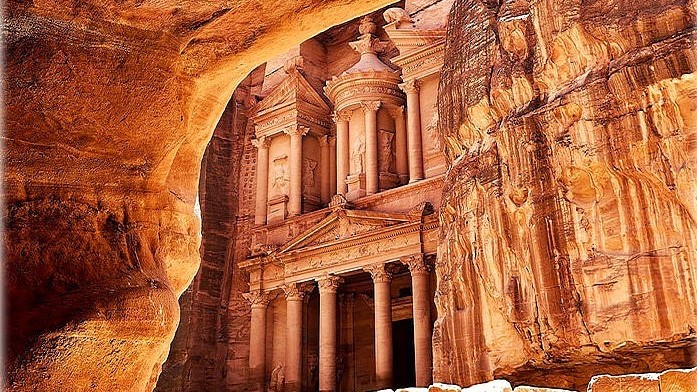
Welcome to Petra "The Lost City of Stone"
Petra, Jordan, is one of the world’s most awe-inspiring historical sites, attracting millions of visitors each year. Known as the “Rose City” for the pinkish hue of its sandstone cliffs, Petra was once the thriving capital of the Nabataean Kingdom, dating back to the 4th century BC. Today, Petra is not only a UNESCO World Heritage Site but also one of the Seven New Wonders of the World, cementing its place in history as a must-visit destination for any traveler.
History of Petra: A Glimpse into the Past
Petra was established as a trading hub and water management marvel by the Nabataeans, a nomadic Arab tribe, around 2,000 years ago. The city flourished in the 1st century AD, and its sophisticated water channels, carved rock architecture, and strategic location along trade routes made it an important center for commerce and culture. Despite its decline in the 4th century, Petra remained hidden from the Western world until it was rediscovered in 1812.
Top Tourist Attractions in Petra
Petra is filled with numerous iconic structures, tombs, and monuments, making it a treasure trove for historians, archaeologists, and tourists alike. Below are some of the most remarkable sites to explore in Petra:
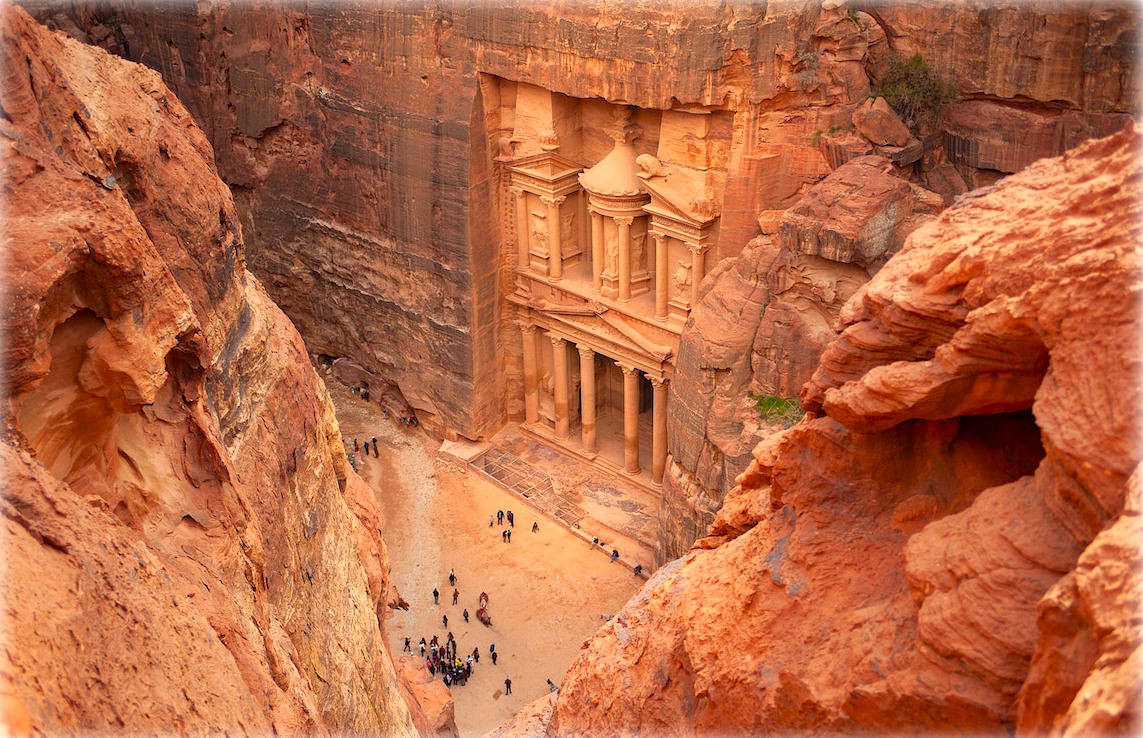
The Treasury (Al-Khazneh): An Icon of Petra's Splendor
The Treasury, or Al-Khazneh, is undoubtedly one of Petra’s most iconic and well-known monuments, drawing visitors from around the globe to marvel at its grandeur. Carved directly into the pink-hued sandstone cliffs, this magnificent structure is a perfect example of the remarkable Nabataean architectural skill. Its façade is intricately designed with a blend of Greek, Roman, and Egyptian influences, reflecting the diverse cultural exchange that took place in Petra at its peak.
Architectural Features:
Al-Khazneh stands 40 meters (131 feet) tall and 25 meters (82 feet) wide, with a grand, highly detailed façade that features a combination of columns, carvings, and sculptures. The design is typical of the Nabataeans’ ability to blend different cultural elements into their architecture. The building’s upper levels display Corinthian-style columns, while the lower part is adorned with intricate carvings of figures, including deities, and a variety of decorative motifs.
The central feature of the Treasury’s facade is a large, urn-like object at the top, which some believe may have been a burial place for a Nabataean king. Legends also surround the Treasury, with local myths suggesting that the urn was filled with treasure and that it was once the hiding place for ancient riches. This belief is partly why the structure was named “The Treasury.”
Symbolism and Historical Significance:
The Treasury’s unique design serves more than just an aesthetic purpose. It is thought to have been a tomb or a royal mausoleum, although the exact purpose of the building remains a subject of debate among historians and archaeologists. Its monumental facade was designed to impress visitors and symbolize the power and wealth of the Nabataean Kingdom, which controlled trade routes across the Arabian Desert. The ornate carvings suggest a blend of cultural influences—Greek columns, Egyptian-style motifs, and the typical Nabataean craftsmanship of intricate rock-cut design. The Treasury’s location at the end of the Siq (the narrow gorge leading into Petra) also contributes to its imposing presence. When visitors first emerge from the Siq, the Treasury dramatically comes into view, its massive façade illuminated by the sun, creating a sense of awe and wonder.
Legends and Myths:
Many myths and legends surround the Treasury, adding an air of mystery to its already stunning appearance. One of the most popular stories is that the urn at the top of the facade once held hidden treasure, possibly from the Egyptian pharaohs. Locals believed that bandits and robbers used to shoot at the urn, trying to find the treasure hidden inside, and this is why the Treasury’s facade is marked with bullet-like marks. However, archaeological studies have not confirmed this treasure legend, and the urn likely served a symbolic or funerary purpose.
The name "Al-Khazneh" translates to “The Treasury” in Arabic, and it is believed that this name was given by Bedouin tribes who once lived in Petra. They likely believed the building contained treasures, due to the structure’s grandeur and the fact that it was largely hidden from view until one emerged from the narrow gorge.
Visiting the Treasury:
When visiting Petra, the Treasury is typically the first major site you encounter after walking through the Siq. The path to reach it is lined with towering rock formations, creating a sense of anticipation and mystery before the awe-inspiring moment when the Treasury reveals itself. The Treasury is particularly stunning at sunrise and sunset when the light reflects off the sandstone, casting beautiful hues of red, pink, and gold across the building’s facade. The contrast between the sun’s golden rays and the cool shadows of the surrounding cliffs creates a magical atmosphere, making it a favorite for photographers and travelers alike.
The Treasury in Popular Culture:
Beyond its historical and archaeological importance, the Treasury has gained significant cultural fame, particularly for its appearance in the Indiana Jones and the Last Crusade movie. In the film, the Treasury is depicted as the location of the Holy Grail, further cementing its status as a symbol of adventure and mystery. This cinematic connection has drawn even more visitors to Petra, eager to see the place that served as the backdrop for one of the world’s most famous film scenes.
Final Thoughts:
The Treasury (Al-Khazneh) is more than just a remarkable structure; it is a symbol of Petra’s rich history, craftsmanship, and cultural significance. It represents the extraordinary achievements of the Nabataeans, who created a thriving, sophisticated civilization in a desert landscape. When you visit Petra, standing before the Treasury offers a profound connection to the past—a moment to marvel at the timeless beauty of one of the world’s greatest architectural wonders.
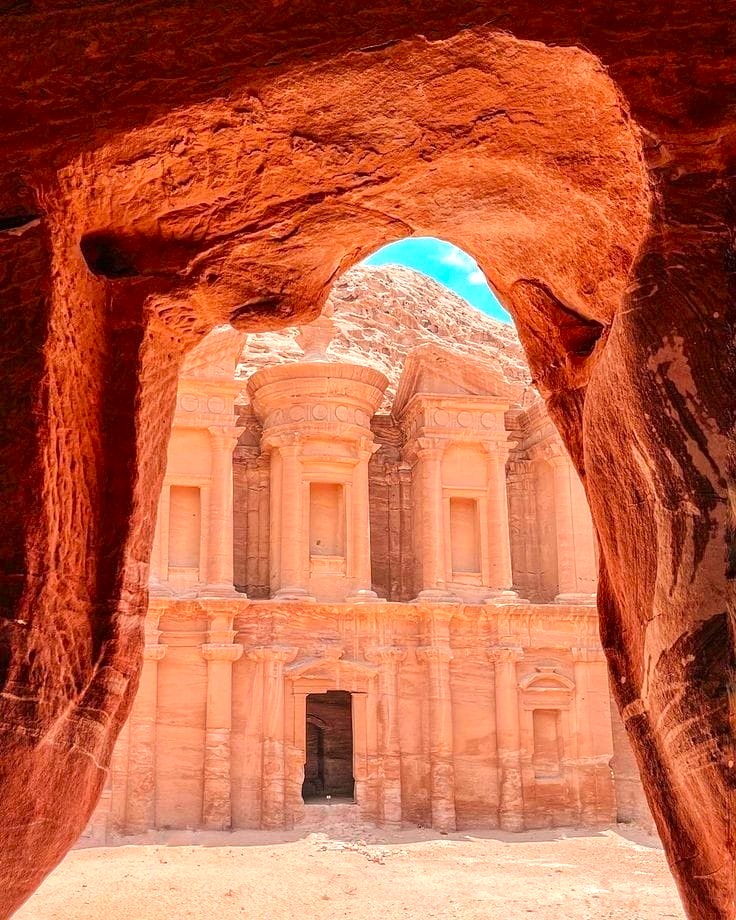
The Siq: Petra’s Narrow Passageway to a Lost City
The Siq (Arabic for "shaft" or "gorge") is one of the most enchanting and awe-inspiring features of Petra, Jordan. It serves as the narrow, winding entrance to the ancient city, guiding visitors through a dramatic passageway of towering rock formations before they emerge into the heart of Petra and encounter the awe-inspiring Treasury (Al-Khazneh). Stretching over 1.2 kilometers (0.75 miles) in length, the Siq is a natural geological wonder, carved over millennia by water and wind. Its narrow path is flanked by walls that rise as high as 80 meters (262 feet) on either side, creating a dramatic and almost mystical atmosphere. The journey through the Siq is like stepping into another world, a journey through time that slowly unfolds as visitors make their way toward one of the most iconic archaeological sites in the world.
A Geological Masterpiece
The Siq is not just a passageway but a geological marvel. It was formed over thousands of years through the erosion of sandstone and limestone by flash floods and the natural forces of wind and rain. The walls of the Siq are striped with stunning layers of pink, red, and orange hues, giving the narrow gorge a mesmerizing and almost otherworldly appearance. As the sunlight filters through the narrow opening above, it casts shifting shadows and highlights on the rock walls, creating a constantly changing play of light and color that captivates visitors. The narrow width of the Siq in some places makes it feel like a hidden, secret passage, intensifying the anticipation and excitement of what lies at the end. The path is sometimes so narrow that the cliffs on both sides seem to close in on you, emphasizing the journey's sense of discovery and mystery.
Historical and Cultural Significance
The Siq was not only a natural marvel but also a vital part of Petra’s urban and economic life. It was through this passage that travelers, traders, and caravans entered Petra, bringing goods and commerce from the distant corners of the ancient world. The Siq was the gateway to the city, which served as a major trade hub along the Nabataean Kingdom’s key trade routes, connecting Arabia, Egypt, and Syria. In addition to its role as an entrance, the Siq was also a place of religious significance for the Nabataeans. Along the walls of the gorge, you can see ancient carvings and reliefs depicting gods, symbols, and figures from Nabataean mythology. These carvings and inscriptions offer a glimpse into the spiritual and cultural life of the people who once inhabited Petra. One of the most famous carvings in the Siq is the Nabataean god Dushara, who was often depicted in the rock walls, a reminder of the city's religious heritage.
The Water Channels of the Siq
Another remarkable feature of the Siq is its ancient water management system. The Nabataeans were known for their innovative and advanced engineering techniques, particularly when it came to managing water in the arid desert landscape of Petra. Along the walls of the Siq, visitors can spot remnants of ancient water channels that once carried water from springs and reservoirs into the heart of the city. These channels were part of an elaborate system of aqueducts and cisterns that allowed Petra to thrive despite the harsh desert climate. The water system not only helped sustain the people of Petra but also contributed to the city’s prosperity by supporting its agricultural needs and supplying water to the public baths and fountains that dotted the urban landscape.
The Siq’s Role in Revealing Petra’s Wonders
As visitors walk through the Siq, there is a palpable sense of anticipation. The journey is often described as a mystical and cinematic experience, where the natural beauty of the gorge, combined with the deep history and legends of Petra, creates an unforgettable sense of wonder. At the end of the Siq, visitors are met with the first view of the Treasury (Al-Khazneh), a breathtaking moment that is one of the highlights of any trip to Petra. The dramatic reveal of the Treasury after the narrow, winding path of the Siq is often described as the most powerful and emotional moment of the entire Petra experience. The grandeur of the Treasury stands in stark contrast to the narrowness of the Siq, highlighting the incredible artistry and engineering of the Nabataean people.
Visiting the Siq: A Journey Through Time
Walking through the Siq is not just about getting from one place to another; it’s about taking a step back in time. The narrow, rock-cut path invites contemplation and a sense of quiet awe, allowing visitors to imagine the ancient traders, pilgrims, and travelers who once walked these very paths. The Siq is also a photographer's paradise. The play of light and shadow, the rich colors of the rock, and the ancient carvings on the walls offer endless opportunities for stunning photographs. Many visitors choose to take their time, soaking in the atmosphere and reflecting on the deep history of this ancient city.
Final Thoughts: The Siq as a Portal to Petra’s Rich History
The Siq is much more than a simple entrance to Petra—it is an entrance to a world of mystery, history, and wonder. It sets the tone for the entire Petra experience, offering a glimpse into the natural beauty and ancient culture that await visitors. Whether you're marveling at the towering sandstone walls, admiring the intricate carvings, or contemplating the ingenuity of the Nabataeans' water management system, the Siq is a truly unforgettable part of the Petra experience. Walking through the Siq, you are not just entering an ancient city—you are stepping into the pages of history, where every twist and turn offers a new story, a new discovery, and a deeper connection to the remarkable civilization that once called Petra home.
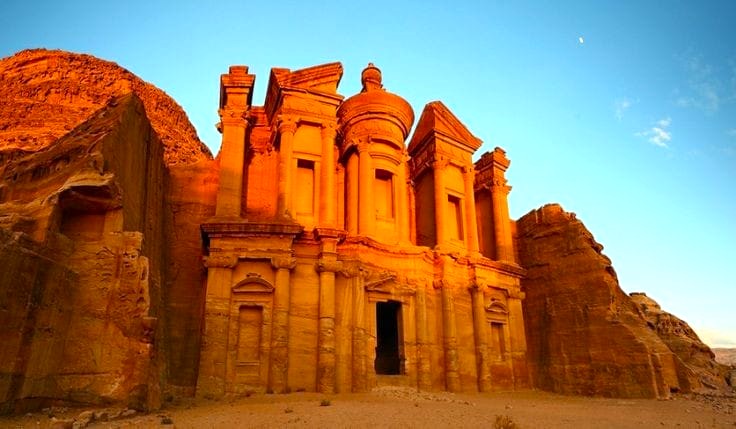
The Monastery (Ad-Deir): Petra’s Majestic Monument
The Monastery (known as Ad-Deir in Arabic), is one of the most impressive and monumental structures in Petra, Jordan. While the Treasury (Al-Khazneh) is more famous due to its iconic position and cinematic presence, the Monastery is equally magnificent and offers a more tranquil and less crowded experience. Carved into the sandstone cliffs in the upper reaches of Petra, this grand structure stands as a testament to the architectural and engineering genius of the Nabataeans. At approximately 45 meters (148 feet) tall and 50 meters (164 feet) wide, the Monastery is similar in design to the Treasury but larger and more isolated, offering a serene atmosphere that contrasts with the bustling nature of the main archaeological site. It is located at the end of a challenging yet rewarding hike, making it a destination for adventurous travelers and those seeking to experience the grandeur of Petra from a different perspective.
Architectural Features
The Monastery’s facade is a stunning example of Nabataean craftsmanship, carved directly into the rock face. Its design is characterized by a large, rectangular doorway flanked by two massive columns. Above the door, intricate carvings and motifs are found, including classical elements such as Corinthian columns and a grand central urn. The structure’s upper sections also feature a large, circular motif resembling a sun disk, which could have had religious or symbolic significance to the Nabataeans. The Monastery’s facade is slightly more weathered than the Treasury due to its exposure to the elements, yet it remains a captivating sight as visitors approach it from the rugged cliffs above Petra. The size of the structure, especially its towering columns and intricate carvings, becomes even more impressive when viewed up close.
Historical and Religious Significance
The exact purpose of the Monastery remains a subject of debate. Like many other structures in Petra, it was likely a religious or ceremonial site. Some historians believe it was a temple dedicated to Nabataean gods or perhaps a place of worship for the deity Dushara, the main god of the Nabataean pantheon. Others suggest it was used as a tomb for a high-ranking figure, similar to the monumental tombs found in other parts of Petra. Its name, Ad-Deir, meaning “the Monastery” in Arabic, suggests that it was used as a place of worship or religious gathering. In the Byzantine period, it is believed that the structure may have been repurposed into a Christian monastery, adding another layer of cultural and religious significance to the building.
The Journey to the Monastery: A Hiker’s Adventure
Getting to the Monastery is not for the faint of heart. The hike to the Monastery involves a steep climb up approximately 800 rock-cut steps, which wind their way up the mountainside. Along the way, you’ll pass breathtaking views of the surrounding desert landscape and Petra's stunning rock formations. The path also offers various panoramic viewpoints that allow hikers to pause, catch their breath, and admire the vastness of the city below. While the hike is challenging, the journey is immensely rewarding. As you ascend, you’ll witness a variety of natural beauty, from the jagged peaks of the surrounding hills to the deep crevices and valleys that crisscross Petra. The Monastery itself, perched on the mountaintop, offers sweeping vistas of the desert and the surrounding Jordanian landscape, making the effort worthwhile.
Views and Atmosphere: Tranquility in Petra
One of the most striking aspects of the Monastery is its location. Unlike the Treasury, which is centrally located and draws crowds from all directions, the Monastery is set high in the mountains, surrounded by the natural beauty of Petra’s rocky landscape. This isolation provides a sense of tranquility and reflection, allowing visitors to escape the hustle and bustle of the more popular areas of Petra. The serene environment around the Monastery is ideal for those seeking a more peaceful and contemplative experience in Petra. The panoramic views from the top, with the soft light of the morning or late afternoon, create a magical atmosphere that captures the essence of Petra’s hidden wonders. Many visitors take the time to sit and enjoy the stunning surroundings before heading back down.
Legends and Myths Surrounding the Monastery
As with many ancient sites, legends and myths surround the Monastery. Local Bedouin tribes, who once inhabited Petra and its surroundings, have long passed down stories about the Monastery’s origins. One of the most intriguing myths involves the large urn at the top of the structure's facade, similar to the urn atop the Treasury. Bedouins have long believed that it contained treasure and that it was the site of hidden riches. Although no treasures have ever been found, this myth continues to add to the Monastery's allure.
In addition, the Monastery’s isolation and commanding position over Petra have contributed to its mystique. It’s often seen as a place of meditation and quiet reflection, away from the more crowded areas of the site.
Visiting the Monastery: Tips and Insights
Final Thoughts: The Monastery’s Enduring Majesty
The Monastery (Ad-Deir) is a true marvel of Petra, offering both historical intrigue and breathtaking natural beauty. Its commanding position, intricate facade, and serene surroundings make it one of Petra’s most memorable landmarks. For those who are up for the challenge, the hike to the Monastery rewards visitors with stunning views, peaceful solitude, and a deeper connection to the timeless wonders of Petra. The Monastery stands not just as an architectural wonder but as a powerful symbol of Petra’s rich cultural and spiritual heritage—a place where history, mythology, and natural beauty converge to create one of the world’s most spectacular monuments.
 The Royal Tombs: A Majestic Burial Complex in Petra
The Royal Tombs: A Majestic Burial Complex in Petra
The Royal Tombs are among the most spectacular and historically significant monuments in Petra, Jordan. Located in the Nabataean city’s upper district, the Royal Tombs consist of a group of monumental rock-cut tombs that were likely the burial sites for the ruling elite of Petra, including kings and high-ranking officials. These tombs are not only impressive in their sheer size but also showcase the remarkable artistic and engineering skills of the Nabataeans. The Royal Tombs are a must-see for anyone visiting Petra. The tombs' striking facades, intricately carved into the rose-red sandstone cliffs, are testament to the grandeur of the Nabataean civilization and their belief in the afterlife. The tombs were designed to be both functional and ceremonial, providing a lasting resting place for the deceased while also reflecting the wealth and power of the ruling class.
Architectural Features and Design
The Royal Tombs are known for their elaborate facades, each one carved with exquisite precision into the cliffs of Petra. The tombs are all similar in their design, featuring large, imposing entrances flanked by columns and intricately detailed decorations. However, each tomb has its unique characteristics, reflecting the artistic and cultural influences of the time.
Cultural and Religious Significance
The Royal Tombs were not merely burial sites but also served as symbols of the wealth, power, and religious beliefs of the Nabataean elite. The elaborate designs, the size of the tombs, and the painstaking craftsmanship suggest that these tombs were built to honor the deceased and ensure their safe journey into the afterlife. The Nabataeans practiced a complex form of ancestor worship and believed in life after death. The royal tombs were thus constructed to house the bodies of the deceased along with offerings and items that would be needed in the afterlife. The tombs were likely designed to be part of a larger funerary complex, with each one acting as a monumental tribute to the deceased’s importance in life.
In addition to their funerary function, the Royal Tombs also played a role in symbolizing the Nabataean Kingdom’s power and influence. Carved into the cliffs of Petra, the tombs were designed to be visible from afar, serving as lasting reminders of the grandeur and reach of the Nabataean civilization.
Legends and Myths of the Royal Tombs
Like many ancient sites, the Royal Tombs are surrounded by legends and myths. One of the most famous myths is that the large urn atop the Urn Tomb contained treasure hidden by the Nabataeans. Local Bedouin tribes believed that the urn was a giant container filled with jewels and precious artifacts, and many tried, unsuccessfully, to find the treasures that were said to be buried there. In addition, there are stories that suggest the tombs were not only places for human burials but also for the burial of royal treasures and sacred relics. While no significant treasure has been found within the tombs, these legends add an aura of mystique and adventure to the already captivating site.
Exploring the Royal Tombs: Tips for Visitors
Final Thoughts: The Royal Tombs as a Symbol of Petra’s Grandeur
The Royal Tombs are a symbol of the Nabataean people’s artistic and architectural mastery, as well as a reminder of the empire’s wealth and influence at the height of Petra’s power. Carved from the rose-red sandstone cliffs, these tombs stand as an enduring tribute to the civilization that once thrived in this desert oasis.
Each tomb tells its own unique story, offering insight into the spiritual beliefs, social structures, and cultural influences of the Nabataeans. Visiting the Royal Tombs is not only a chance to admire some of the most impressive examples of ancient rock-cut architecture but also an opportunity to connect with the rich history of Petra and the Nabataean Kingdom.
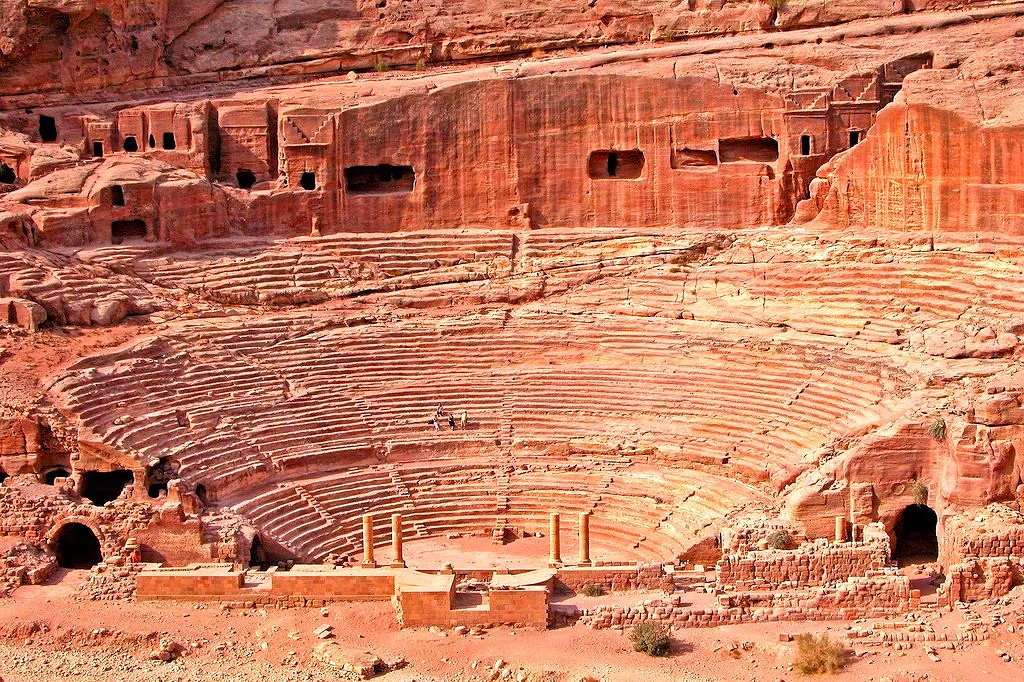
The Roman Theater: Petra’s Architectural and Cultural Heart
The Roman Theater is one of the most iconic and well-preserved structures in Petra, Jordan, and it offers a fascinating glimpse into the cultural and architectural influence of the Roman Empire on this ancient city. Located in the lower part of Petra, near the heart of the ancient city, the theater is a testament to the blending of Nabataean and Roman architecture, offering a unique perspective on the intersection of two great civilizations. Built during the 1st century CE, likely during the reign of Emperor Trajan, the Roman Theater is one of Petra’s most impressive landmarks. With a seating capacity of approximately 3,000 to 3,500 spectators, the theater was a grand venue for public events, performances, and entertainment in the ancient city. Despite its Roman design, the theater was carefully integrated into the surrounding Nabataean landscape, making it a prime example of cultural fusion.
Architectural Features and Design
The Roman Theater is carved directly into the sandstone rock of Petra, showcasing the Nabataeans’ remarkable ability to work with the region’s natural resources. The theater’s semi-circular structure is one of the key features that aligns it with Roman engineering traditions. The stage is positioned at the base of the theater, with the audience rising in tiered seats behind it, offering a panoramic view of the surrounding cityscape.
Cultural and Social Significance
The Roman Theater was an important social and cultural venue in ancient Petra. During the Roman period, it would have hosted a wide variety of events, ranging from theatrical performances and musical concerts to public speeches, rituals, and even political gatherings. The theater likely played a central role in the lives of Petra's citizens, offering entertainment and cultural enrichment in an era of political and economic change. The theater's size and design suggest it was used by the elite of Petra, including visiting Roman officials and the Nabataean royalty. It is believed that the theater would have been a space for important public ceremonies, making it a symbol of both civic pride and the blending of Roman and Nabataean traditions in the city’s governance and culture.
Roman Theater's Role in Petra's Decline and Legacy
While Petra flourished under Nabataean rule and during the Roman period, its decline began in the 3rd and 4th centuries CE, due to a combination of factors such as changing trade routes, earthquakes, and the increasing Roman imperial instability. Despite this, the Roman Theater continued to serve as a cultural landmark throughout the centuries. Even after Petra was abandoned by the Nabataeans, the theater’s design and layout remained an essential piece of the city’s historical landscape. The theater was rediscovered in the early 19th century, and its restoration has allowed modern visitors to appreciate its grandeur and architectural significance. Today, the theater serves not only as a popular tourist attraction but also as a symbol of Petra’s deep cultural heritage, blending the influences of both the Nabataeans and the Romans who shaped the city’s history.
Visiting the Roman Theater: An Immersive Experience
The Roman Theater offers visitors an immersive experience, where they can sit in the ancient seats and imagine what it would have been like to witness a performance centuries ago. It’s one of the few places in Petra where you can interact directly with the site’s historical architecture, giving you a sense of the atmosphere during the time it was in use.
Final Thoughts: The Roman Theater’s Enduring Grandeur
The Roman Theater in Petra stands as a monumental testament to the cultural fusion between the Nabataean and Roman civilizations, showcasing the artistic and architectural achievements of both cultures. Though originally a site for entertainment and public gatherings, the theater now serves as a silent observer of Petra's evolution over time, from a thriving Nabataean trading hub to its integration into the Roman Empire. The Roman Theater remains one of the most important and well-preserved structures in Petra, offering visitors a chance to step back in time and experience the grandeur and cultural richness of this remarkable ancient city. Whether you’re attending a performance (as is occasionally done in modern times), simply exploring the site, or reflecting on its historical significance, the theater is a must-see in Petra—a symbol of the city’s dynamic and storied past.
Hiking and Exploring Petra: A Traveler’s Guide
For those looking for more adventure, Petra offers several hiking trails that provide stunning views of the entire archaeological site. Some of the most popular trails include:
Best Time to Visit Petra
The best time to visit Petra is during the spring (March to May) and fall (September to November), when the weather is mild and comfortable. Summer temperatures can be very hot, especially in the desert areas, making spring and fall ideal for exploring the site.
How to Get to Petra
Petra is located in southern Jordan, about a 3-hour drive from Amman, the capital of Jordan. Visitors can reach Petra by car, taxi, or private tour from major cities in Jordan. The nearest town to Petra is Wadi Musa, where many hotels and accommodations are available for travelers.
Tips for Visiting Petra
Conclusion: Petra – A Journey Through Time
Visiting Petra is like stepping back in time to an ancient city carved into stone. Whether you're marveling at the Treasury, hiking through the Siq, or exploring the Royal Tombs, Petra offers a fascinating journey through history, architecture, and natural beauty. As one of the Seven New Wonders of the World, it’s a destination every traveler should experience at least once in their lifetime.